Antarctica is the fifth-largest continent and remains the most uninhibited place in the world. Its extremely cold climate makes it a pretty hostile place for humans, as well as its icy landmass and dry, windy weather.
The only signs of life you’ll find on the continent are scientific research stations. Between 1000 and 5000 scientists live temporarily on the continent every year, usually researching geology, animals and plants, or climate change.
Leningradskaya Station was once a bustling hive of activity for the USSR, but it now stands unoccupied, serving as a lonely reminder of the Cold War in an unforgiving environment. The closest city to this station lies hundreds of miles away in South America – Ushuaia, the beautiful port city in Argentina.
Built in 1971, the Soviets named the station after Leningrad, now known as Saint Petersburg, on the desolate plains of Queen Mary Land.
This is an area of the world where temperatures can get as cold as -50C, and the sun will disappear for months at a time during the depths of winter. It’s certainly not for the faint of heart.
The Soviets were proud of their scientific achievements at the time, and Leningradskaya Station was very much a symbol of that.
The scientists working at the station arrived each summer by ship, bringing food supplies such as coffee, powdered milk, and newspapers to read.
Soviet meteorologists, glaciologists, oceanologists and geophysicists worked at the station gathering scientific data on the Earth’s climate.
The station has been abandoned since 1991, when the Soviet Union collapsed, and remains untouched on the northern shore of Victoria Land, at the Oates Coast. It now exists as a time capsule, frozen in the icy desert.
People and researchers have visited the ghostly station since its closure, but it is mainly left to ruin, steeped in ice and snow.
While Leningradskaya Station remains abandoned, Russia has continued its scientific research across Antarctica. There are 10 active Russian research stations on the continent, including the recently modernised Vostok Station, while the UK has five Antarctic stations.
Antarctica has a long and rich history of scientific research. There are 70 permanent stations scattered across the continent, representing countries from all over the world.
All of the countries are signatories of the Antarctic Treaty, and must ensure the preservation and well-being of the natural land, and cooperate peacefully with their fellow explorers.

